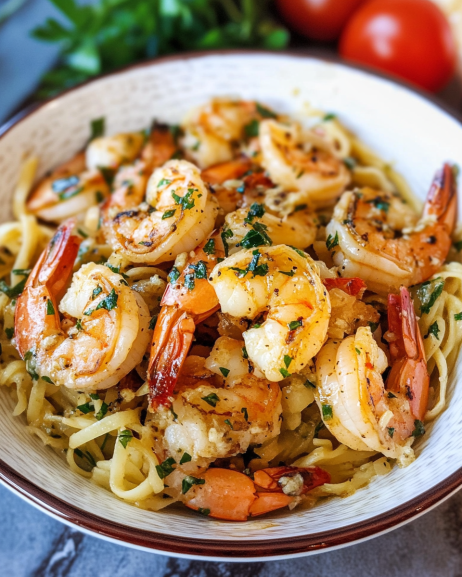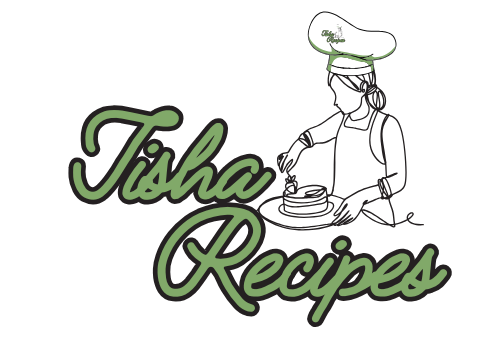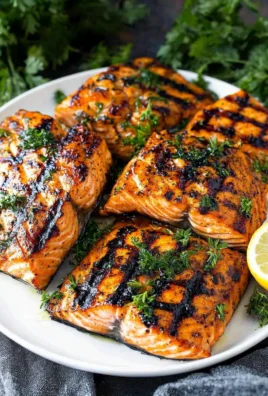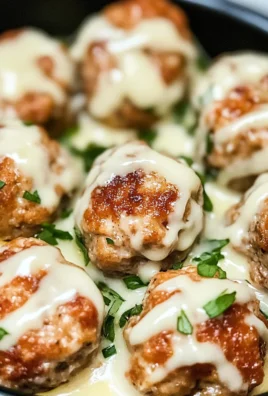
Garlic Butter Shrimp Scampi is a timeless dish that marries simplicity with elegance. This Italian-American favorite is celebrated for its rich garlic-infused butter sauce, tender shrimp, and a hint of zesty lemon. It’s a versatile recipe, perfect for casual family dinners, romantic date nights, or sophisticated gatherings. Despite its gourmet flavor profile, Shrimp Scampi is quick and easy to prepare, making it a go-to choice for cooks of all skill levels.
Overview of Garlic Butter Shrimp Scampi
The term “scampi” originally referred to small crustaceans like langoustines, commonly used in Italian coastal dishes. However, as the recipe migrated to America, shrimp became the star ingredient, replacing langoustines due to their availability. This modern adaptation maintains the essence of the original dish while embracing local ingredients. At its core, Garlic Butter Shrimp Scampi consists of sautéed shrimp cooked in a luxurious sauce of garlic, butter, olive oil, white wine, and lemon juice, often served over pasta, rice, or crusty bread.
Historical Background
The origins of scampi dishes can be traced to Italian seaside towns, where fresh shellfish were abundant. In traditional recipes, langoustines were cooked with olive oil, garlic, parsley, and sometimes white wine. When Italian immigrants brought the recipe to the United States, shrimp—a more accessible and affordable option—became the preferred choice. The addition of butter, an ingredient not traditionally used in Italian cuisine, reflects the influence of American cooking preferences. Over time, Garlic Butter Shrimp Scampi evolved into a signature dish that balances the rustic simplicity of Italian cooking with the indulgent richness of American flavors.
Key Ingredients and Their Roles
- Shrimp
- Selection: Large shrimp (16–20 per pound) work best for this recipe, providing a meaty texture and presence in the dish.
- Preparation: Deveining and peeling are essential steps to ensure clean presentation and flavor. Leaving the tails on can enhance visual appeal but is optional.
- Garlic
- Role: The heart of the dish, garlic infuses the butter and oil with its pungent aroma and savory depth.
- Preparation: Minced garlic ensures even distribution, while thinly sliced garlic adds a milder flavor.
- Butter and Olive Oil
- Butter: Adds richness and a silky texture to the sauce. Use unsalted butter to control seasoning levels.
- Olive Oil: Balances the butter’s heaviness and prevents it from burning during cooking.
- White Wine
- Selection: A dry white wine like Sauvignon Blanc, Pinot Grigio, or Chardonnay enhances the sauce with subtle acidity and fruity undertones.
- Substitution: Chicken broth with a splash of lemon juice works well if wine isn’t an option.
- Lemon Juice and Zest
- Juice: Brightens the dish, cutting through the richness of the butter and complementing the shrimp’s natural sweetness.
- Zest: Adds an aromatic citrus note, elevating the overall flavor.
- Fresh Herbs
- Parsley: The traditional choice for garnish, adding freshness and color.
- Optional: Dill or chives for a subtle variation in flavor.
- Red Pepper Flakes
- Adds a gentle kick of heat, balancing the dish’s buttery richness.
- Seasonings
- Salt and Pepper: Essential for enhancing the natural flavors of the ingredients.
- Paprika: Optional for a touch of smokiness and color.
Essential Equipment
- Skillet or Sauté Pan
- A large, heavy-bottomed skillet ensures even cooking and prevents overcrowding the shrimp. A stainless steel or cast-iron pan works best for developing a good sear.
- Tongs
- Useful for flipping shrimp gently without tearing their delicate flesh.
- Microplane or Zester
- For grating lemon zest finely and evenly, enhancing the sauce’s aroma.
- Garlic Press or Chef’s Knife
- A garlic press saves time during preparation, while a knife allows for more control over garlic texture.
- Wooden Spoon or Silicone Spatula
- Ideal for stirring and scraping the pan to incorporate the browned bits into the sauce.
Preparation Steps
- Prepare the Shrimp
- Peel and devein the shrimp, leaving tails intact if desired. Pat them dry with paper towels to ensure a good sear. Season the shrimp lightly with salt and pepper.
- Mise en Place
- Measure and prepare all ingredients before cooking. Mince the garlic, chop the parsley, zest and juice the lemon, and have your wine ready. This ensures a smooth cooking process.
- Sear the Shrimp
- Heat olive oil and butter in the skillet over medium-high heat. Once the butter melts and starts to foam, add the shrimp in a single layer. Cook for 1–2 minutes per side until they turn pink and opaque. Remove the shrimp and set aside.
- Sauté the Garlic
- Lower the heat to medium. Add the minced garlic to the pan and sauté for 30 seconds until fragrant. Be careful not to burn the garlic, as it can become bitter.
- Deglaze the Pan
- Pour the white wine into the skillet, scraping the bottom with a wooden spoon to incorporate any browned bits. Let the wine simmer for 2–3 minutes to reduce slightly and concentrate its flavor.
- Add Lemon and Butter
- Stir in the lemon juice, lemon zest, and additional butter. Swirl the pan to emulsify the sauce, creating a rich, glossy texture.
- Return the Shrimp to the Pan
- Add the cooked shrimp back into the skillet, tossing to coat them evenly in the sauce. Cook for an additional minute to warm through.
- Finish with Parsley and Red Pepper Flakes
- Sprinkle chopped parsley and a pinch of red pepper flakes over the dish, stirring gently to combine.
- Serve Immediately
- Plate the Shrimp Scampi over pasta, rice, or crusty bread. Garnish with extra parsley and lemon wedges for presentation.
Serving Suggestions
Pasta
- Toss the Shrimp Scampi with linguine, spaghetti, or fettuccine, ensuring the sauce coats the pasta evenly.
Rice or Grains
- Serve over fluffy white rice, risotto, or quinoa for a hearty and gluten-free option.
Crusty Bread
- Pair with warm, crusty bread to soak up the rich, garlicky sauce.
Vegetables
- For a lighter meal, serve the scampi over sautéed zucchini noodles, steamed broccoli, or roasted asparagus.
Advanced Cooking Techniques and Flavor Variations
Garlic Butter Shrimp Scampi is a versatile dish that can be tailored to suit a variety of tastes, preferences, and occasions. By exploring advanced cooking techniques, creative ingredient substitutions, and unique serving styles, you can elevate this classic dish into a culinary masterpiece.
1. Advanced Culinary Techniques
Emulsifying the Sauce
- Achieve a silky, cohesive sauce by emulsifying butter with the wine and lemon juice. Constantly swirl or whisk the pan as you incorporate the butter, preventing separation.
Flambéing with Alcohol
- Add a dramatic flair by flambéing the garlic and shrimp with a splash of brandy or cognac before deglazing with wine. The flame enhances the caramelization and depth of flavor.
- Always use caution: remove the pan from direct heat when adding alcohol, and ignite with a long lighter or match.
Infusing Flavors
- Infuse the olive oil or butter with aromatics like garlic, shallots, or thyme before cooking the shrimp. This creates a layered, aromatic base for the dish.
- Strain the infused oil to remove solids before continuing with the recipe for a refined texture.
Pan Searing Shrimp
- For a crispy exterior, dredge the shrimp lightly in seasoned flour before searing. This adds a delicate crust and helps thicken the sauce slightly.
Using High-Quality Ingredients
- Enhance the dish by using artisanal butter, single-origin olive oil, or freshly pressed lemon juice. Small upgrades in ingredient quality can significantly impact the flavor.
2. Creative Flavor Variations
Spicy Scampi
- Add a bold kick by increasing the red pepper flakes or incorporating fresh chili peppers, like Thai bird’s eye or Fresno chilies, finely sliced.
- For a smoky heat, use chipotle powder or smoked paprika.
Herbaceous Scampi
- Experiment with alternative herbs like tarragon, basil, or dill for unique flavor profiles.
- Combine multiple herbs to create a more complex, aromatic dish.
Tomato-Based Scampi
- Add diced cherry tomatoes or a spoonful of tomato paste for a tangy, slightly sweet variation.
- For a richer sauce, include a splash of tomato passata or marinara.
Creamy Scampi
- Stir in a splash of heavy cream or crème fraîche for a velvety, indulgent sauce.
- Balance the richness by increasing the lemon juice or adding a touch of white wine vinegar.
Asian-Inspired Scampi
- Substitute soy sauce for salt and add ginger and sesame oil for an umami-rich twist.
- Garnish with scallions and toasted sesame seeds for a fusion-style dish.
Citrus Medley Scampi
- Replace lemon juice with a combination of citrus, such as orange, lime, or grapefruit, for a vibrant and slightly sweet flavor profile.
3. Protein Substitutions and Additions
Seafood Variations
- Substitute shrimp with scallops, lobster tails, or crab meat for an upscale twist. Adjust cooking times to prevent overcooking these delicate proteins.
- Combine different seafood options for a luxurious medley.
Non-Seafood Alternatives
- Use chicken tenders or thinly sliced pork tenderloin for a land-based version of scampi.
- For a vegetarian option, replace shrimp with sautéed mushrooms or roasted cauliflower.
Surf and Turf Scampi
- Pair the shrimp with steak medallions or sliced sausage for a hearty, protein-rich dish.
4. Dietary Modifications
Gluten-Free Adaptations
- Replace traditional pasta with gluten-free options like chickpea or lentil pasta.
- Serve over rice, polenta, or spiralized vegetables for a naturally gluten-free base.
Dairy-Free Scampi
- Use plant-based butter or olive oil exclusively to omit dairy while maintaining richness.
- Add a splash of coconut milk or almond cream for a creamy dairy-free alternative.
Low-Carb or Keto Scampi
- Serve the shrimp over zucchini noodles, spaghetti squash, or mashed cauliflower instead of pasta or rice.
- Increase the olive oil and butter while reducing the wine to maintain keto-friendly macros.
5. Pairing and Serving Suggestions
Pasta Options
- Beyond traditional linguine or spaghetti, consider pairing the scampi with fettuccine, pappardelle, or angel hair pasta for textural variety.
- Toss the cooked pasta directly in the sauce to absorb the flavors.
Grain and Legume Bases
- Serve the shrimp scampi over risotto, couscous, or creamy polenta for a hearty, comforting base.
- Lentils or quinoa provide a protein-packed alternative for vegetarian or health-conscious diners.
Bread Pairings
- Accompany the dish with garlic bread, focaccia, or a baguette to mop up the garlicky sauce.
- For an elevated touch, use herb-infused butter on the bread.
Vegetable Sides
- Pair with roasted asparagus, sautéed spinach, or steamed broccoli for a well-rounded meal.
- Add grilled zucchini or roasted cherry tomatoes for a seasonal twist.
Wine Pairings
- A dry white wine like Pinot Grigio, Sauvignon Blanc, or Chardonnay complements the dish’s buttery, garlicky flavors.
- For a sparkling option, Prosecco adds a refreshing, crisp balance.
Non-Alcoholic Options
- Serve with a lemon-lime soda, sparkling water with a twist of citrus, or a chilled herbal tea infused with mint or basil.
6. Presentation Tips
Plating for Elegance
- Arrange the shrimp over the base (pasta, rice, etc.) in a circular or linear pattern for a polished look.
- Drizzle additional sauce over the shrimp and garnish with fresh herbs and lemon slices.
Family-Style Serving
- Present the shrimp scampi in a large skillet or shallow serving dish, allowing guests to help themselves.
- Garnish generously with chopped parsley and lemon wedges for added visual appeal.
Individual Portions
- Plate the scampi in shallow bowls, ensuring each serving includes a generous amount of sauce.
- Top with freshly grated Parmesan or Pecorino Romano for an extra layer of flavor.
7. Leftover Ideas
Shrimp Scampi Risotto
- Combine the leftover scampi with cooked Arborio rice, butter, and chicken broth. Stir until creamy and heated through.
Scampi-Stuffed Bell Peppers
- Mix the shrimp and sauce with cooked rice or quinoa. Stuff the mixture into halved bell peppers and bake until tender.
Shrimp Scampi Pizza
- Spread the sauce over a pizza crust, add shrimp, mozzarella, and fresh herbs, then bake until golden and bubbly.
Scampi Salad
- Serve the shrimp cold over mixed greens with a lemon-garlic vinaigrette for a refreshing twist.
Shrimp Scampi Soup
- Thin the sauce with chicken broth, add diced potatoes or rice, and simmer for a comforting seafood soup.
Storing, Reheating, and Repurposing Leftovers
Garlic Butter Shrimp Scampi is not only a delight fresh off the stove but also a versatile dish that can be stored, reheated, and reinvented into exciting new meals. Proper handling of leftovers ensures the dish retains its original flavors while giving you opportunities to explore creative ways to enjoy it again.
1. Storing Garlic Butter Shrimp Scampi
Refrigeration
- Allow the dish to cool to room temperature before transferring it to an airtight container.
- Store the shrimp and sauce together, and if served with pasta or rice, keep them separate to prevent over-softening.
- Refrigerate for up to 3 days to maintain freshness and flavor.
Freezing
- Shrimp Scampi can be frozen, though the texture of the shrimp may change slightly upon reheating.
- Place the shrimp and sauce in a freezer-safe container, leaving some space at the top to allow for expansion.
- Label the container with the date and freeze for up to 2 months. For best results, freeze the shrimp separately from pasta or other bases.
Thawing Frozen Scampi
- Thaw overnight in the refrigerator or use the defrost setting on a microwave if reheating immediately.
2. Reheating Garlic Butter Shrimp Scampi
Stovetop Method (Best for Texture)
- Heat a skillet over medium heat and add the scampi along with a splash of chicken broth, white wine, or water to loosen the sauce.
- Stir gently and heat until warmed through. Avoid overcooking the shrimp, as this can make them rubbery.
Microwave Method (Quick and Convenient)
- Transfer the scampi to a microwave-safe dish, covering it loosely with a microwave-safe lid or plastic wrap with a vent.
- Heat in 30-second intervals, stirring between each to ensure even reheating. Add a small amount of liquid if the sauce appears too thick.
Oven Method (For Larger Quantities)
- Preheat the oven to 300°F (150°C). Place the scampi in an oven-safe dish, cover with foil, and bake for 15–20 minutes.
- Stir halfway through and add liquid if needed to maintain the sauce’s creamy consistency.
Tips for Reheating
- Always reheat gently to prevent overcooking the shrimp or separating the sauce.
- Avoid boiling the sauce, as this can cause the butter to break and lose its creamy texture.
3. Creative Ways to Repurpose Leftovers
Transform your leftover Garlic Butter Shrimp Scampi into new dishes with minimal effort.
Shrimp Scampi Risotto
- Chop the leftover shrimp into bite-sized pieces and stir them into a creamy risotto.
- Use the leftover sauce as part of the liquid for cooking the rice, adding chicken or seafood stock as needed.
Shrimp Scampi Pasta Bake
- Combine the leftover shrimp and sauce with cooked pasta. Transfer to a baking dish, top with breadcrumbs and grated Parmesan, and bake at 375°F (190°C) until golden and bubbly.
Scampi-Stuffed Vegetables
- Hollow out zucchini, bell peppers, or portobello mushrooms, and stuff them with a mixture of the scampi and cooked rice or quinoa. Bake until the vegetables are tender.
Shrimp Scampi Pizza
- Use the leftover sauce as a pizza base. Top with the shrimp, shredded mozzarella, and a sprinkle of red pepper flakes. Bake until the crust is golden and the cheese is melted.
Shrimp Scampi Wraps
- Wrap the shrimp and sauce in warm tortillas or flatbreads with arugula, diced tomatoes, and a drizzle of garlic aioli.
Shrimp Scampi Salad
- Serve the shrimp cold over mixed greens, cherry tomatoes, cucumbers, and avocado. Use the leftover sauce as a flavorful dressing base, thinned with lemon juice or olive oil.
Shrimp Scampi Soup
- Thin the sauce with seafood or chicken broth, adding diced potatoes, carrots, or other vegetables for a comforting soup.
Shrimp Scampi Fried Rice
- Toss chopped shrimp and sauce with cooked rice, scrambled eggs, and vegetables in a hot skillet. Add a splash of soy sauce for an Asian-inspired twist.
Shrimp Scampi Toast
- Spread the sauce over toasted baguette slices and top with shrimp for a quick appetizer or snack.
4. Frequently Asked Questions (FAQs)
Can I freeze Garlic Butter Shrimp Scampi?
- Yes, though freezing may slightly alter the shrimp’s texture. For best results, freeze the shrimp and sauce separately from any pasta or rice.
How do I keep reheated shrimp from becoming rubbery?
- Reheat gently over low heat, adding a splash of liquid to the sauce to prevent it from drying out. Avoid prolonged cooking times.
Can I make Scampi ahead of time?
- Yes, prepare the sauce in advance and store it separately. Cook the shrimp and combine with the sauce just before serving to maintain optimal texture and flavor.
What’s the best way to serve leftover Scampi?
- Serve leftovers as part of a new dish, such as a risotto, pasta bake, or salad, to create variety and avoid repetitiveness.
What if my sauce separates when reheating?
- Add a small pat of butter and a splash of water or broth, whisking vigorously to bring the sauce back together.
Can I use frozen shrimp for Scampi?
- Yes, frozen shrimp work well as long as they are thawed completely and patted dry before cooking.
How long can I store leftovers in the fridge?
- Leftovers can be refrigerated for up to 3 days if stored in an airtight container.
Can I use the leftover sauce with other proteins?
- Absolutely! The sauce pairs wonderfully with chicken, scallops, or even grilled vegetables.
Conclusion
Garlic Butter Shrimp Scampi is a dish that keeps on giving. Proper storage and reheating techniques ensure you can savor its rich, garlicky flavors even as leftovers. By repurposing the dish into risottos, casseroles, or even soups, you can enjoy exciting variations of this timeless recipe. Whether served fresh or creatively reinvented, Shrimp Scampi remains a versatile and satisfying addition to your culinary repertoire.




Leave a Comment